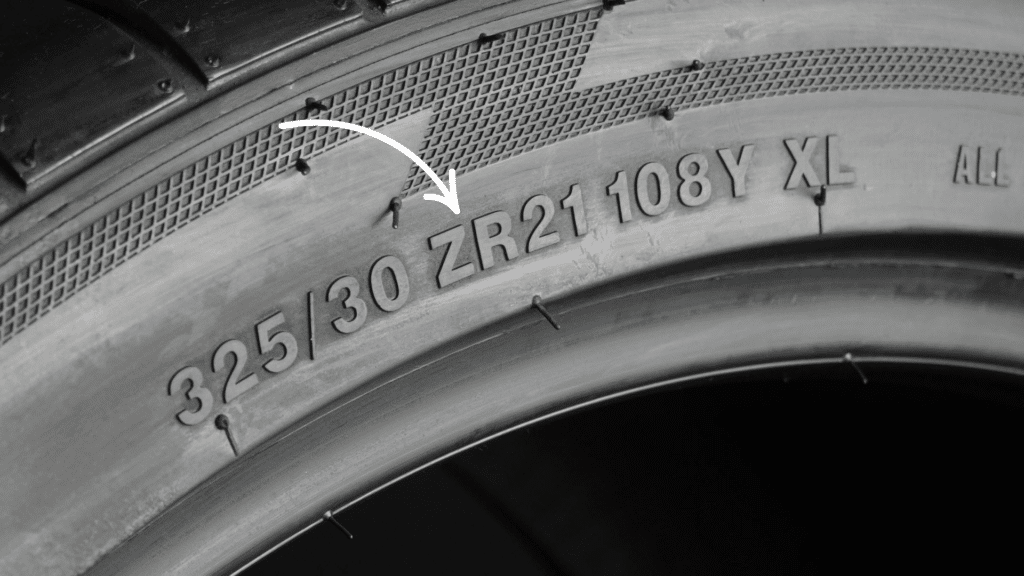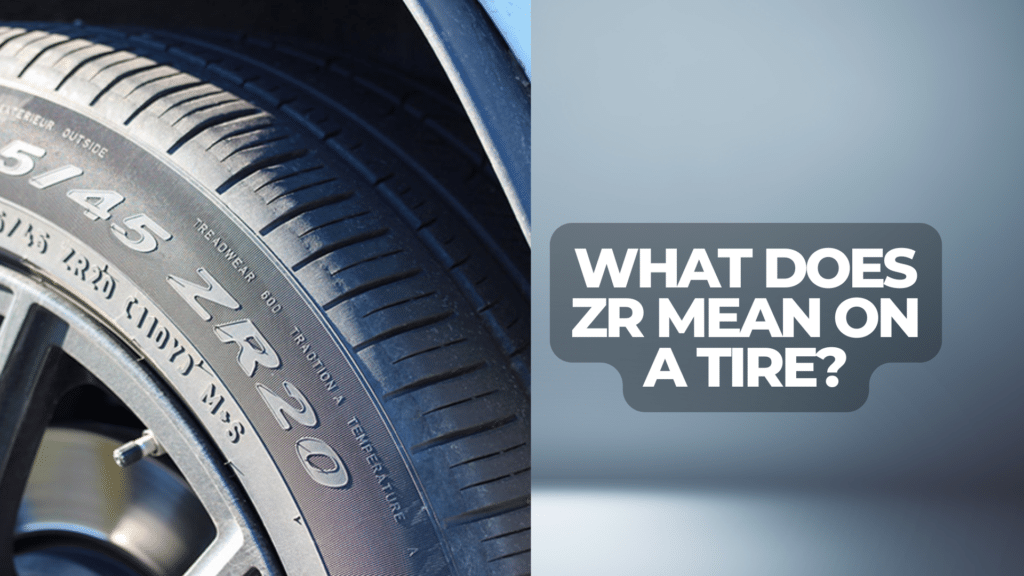Tires are an important part of your vehicle, and understanding their markings can help you choose the right one.
One common label you may see is “ZR.” But what does ZR mean on a tire? This marking is related to the tire’s speed rating, which tells you how fast the tire can safely go.
The ZR label indicates a tire that can handle higher speeds, typically over 149 mph (240 km/h). It is often found on performance and sport tires.
In this guide, I’ll explain the ZR label, how it affects your tire’s performance, and why it’s important to know when choosing the right tires for your car.
Understanding these markings can help you make better safety and driving performance choices.
What is a Tire Speed Rating?
Before we understand what ZR means, it’s important to understand tire speed ratings in general. A tire speed rating is a letter or combination of letters printed on the side of the tire.
It tells you the maximum speed the tire can handle safely under specific conditions. This rating is crucial because it helps ensure that the tires you choose are suitable for your vehicle’s speed range.
The Importance of Speed Ratings
Tires are made with specific materials and designs that allow them to perform well at certain speeds. When a tire is rated for a higher speed, it means it’s built to handle the heat, pressure, and stress of driving at higher speeds.
If a tire isn’t rated for your driving speed, it can overheat, lose traction, or even fail. Knowing your tire’s speed rating is important for both safety and performance.
What Does ZR Mean?

Now, let’s focus on what ZR means specifically. The “Z” in ZR is a high-speed rating, typically above 149 mph (240 km/h).
This rating is for tires designed to handle faster speeds, which is why you’ll often see ZR tires on performance cars, sports cars, and high-performance vehicles. The “R” in ZR means the tire is radial.
Most modern tires are radial, which means the tire’s layers run radially from the center of the tire. Radial tires are common because they provide better performance and durability than other tires.
History of ZR Tires
The term “ZR” was first introduced in the 1980s by the tire industry to identify tires designed for high-performance vehicles.
Before that, tires were typically rated by a single letter, such as “S” for speeds up to 112 mph or “H” for speeds up to 130 mph.
As vehicles became more powerful and capable of reaching higher speeds, the need for tires that could safely handle those speeds grew. The ZR designation was introduced to clarify that these tires were rated for speeds over 149 mph.
Why Do ZR Tires Matter?
ZR tires are built for high-speed performance, and they’re designed to provide better handling, grip, and stability at higher speeds.
If you’re driving a sports car, a high-performance vehicle, or any car capable of reaching speeds over 150 mph, ZR-rated tires are crucial for maintaining control and safety. High-speed driving puts a lot of stress on tires. They generate more heat, and the pressure increases as you drive faster.
Tires with a ZR rating are specially designed to manage these challenges. They often have stronger sidewalls, more durable rubber compounds, and patterns designed to provide better grip on the road at high speeds.
What Makes ZR Tires Different from Other Tires?
While all tires are built to support a certain speed, ZR tires are unique in their ability to handle much higher speeds. How ZR tires differ from regular tires are:
-
Higher Speed Capacity: ZR tires are designed for speeds above 149 mph, which is much faster than most standard tires, which are typically rated for speeds of 112 mph (S rating) or 130 mph (H rating).
-
Performance-Boosting Design: ZR tires are often designed with more advanced tread patterns, rubber compounds, and sidewall construction to improve handling, cornering, and stability at higher speeds.
-
Durability: ZR tires are built to be more durable, as they are designed to handle high-speed driving. They can withstand the heat and pressure generated during fast driving, which helps prevent blowouts or tire failure.
-
Sports Car Applications: ZR tires are most commonly used on sports cars, performance cars, and other vehicles built to go fast. These vehicles demand tires that can keep up with their high-performance engines.
How to Read a Tire Sidewall
If you’ve ever looked at the sidewall of a tire, you may have noticed a series of numbers and letters. These markings contain important information about the tire, including its size, speed rating, and load capacity:
Example: 225/45ZR17
-
225: This number refers to the width of the tire in millimeters. In this case, the tire is 225 millimeters wide.
-
45: This number is the aspect ratio, which is the ratio of the tire’s height to its width. A 45 aspect ratio means the height of the tire is 45% of its width.
-
ZR: As we’ve discussed, the ZR indicates that the tire is rated for high speeds (over 149 mph) and is a radial tire.
-
17: This is the diameter of the wheel that the tire fits, measured in inches. So, this tire is designed to fit a 17-inch wheel.
Understanding how to read these markings is crucial when choosing new tires for your vehicle. If you have a high-performance car, you’ll want to ensure the tires you choose are rated for the speeds you plan to drive.
ZR Tires and Performance
ZR tires are mainly used on performance cars because they enhance a vehicle’s handling and stability.
When driving at high speeds, tires play a huge role in maintaining control of the car. ZR tires provide better traction, cornering, and braking performance, especially when driving on dry roads or in ideal conditions.
-
Better Handling: ZR tires are designed with tread patterns that enhance grip, which helps the vehicle handle better, especially in high-speed turns.
-
Stability: The sidewalls of ZR tires are typically stiffer, which helps provide better stability at high speeds, reducing the likelihood of wobbling or instability.
-
Improved Braking: ZR tires often have more responsive braking characteristics, which are essential for stopping quickly at high speeds.
-
Traction: The rubber compounds used in ZR tires are designed to stick better to the road, offering more traction. This is especially helpful in dry conditions but can also improve performance in wet conditions.
Should You Choose ZR Tires?
If you drive a high-performance or sports car, choosing ZR-rated tires is a good idea. They’re designed for these vehicles’ high-speed capabilities and can help improve handling, cornering, and stability.
However, if you drive a standard car and rarely exceed speeds of 100 mph, you may not need ZR-rated tires. In this case, a tire with a lower speed rating would be sufficient and more cost-effective.
ZR tires are typically more expensive than regular tires, so it’s important to choose the right tire based on your driving needs.
If you don’t often drive at high speeds, opting for a tire with a lower speed rating can save you money while providing the safety and performance you need.
How Long Do ZR Tires Last?
The lifespan of ZR tires depends on various factors, including how often you drive at high speeds, the condition of the roads, and how well you maintain the tires.
Generally, high-performance tires like ZR tires wear out faster than regular tires due to the softer rubber compounds used for better grip.
This means you may need to replace them more often, especially if you’re driving on them frequently at high speeds.
Proper tire maintenance, such as inflating your tires, rotating them regularly, and checking for damage, can help extend their lifespan.
Conclusion
ZR-rated tires are an essential part of high-performance vehicles. They are designed to handle the stresses of high-speed driving and provide better stability, handling, and traction.
Whether driving a sports car or a high-performance vehicle, ZR tires are built to meet the demands of fast speeds and aggressive driving.
Understanding the meaning behind the ZR marking on your tires can help you make informed decisions about replacing or upgrading them.
If you have a vehicle that requires ZR tires, it’s important to choose the right tires for your needs. When selecting tires, always consider your driving habits, vehicle performance, and the conditions in which you drive.
Frequently Asked Questions
Are ZR tires good for wet weather driving?
ZR tires are designed for high-speed dry conditions. While they offer good traction on dry roads, they may not perform as well in wet conditions compared to all-season or wet-weather tires, so it’s essential to consider your driving environment.
Can I replace ZR tires with regular tires?
It’s possible to replace ZR tires with regular tires, but it’s not recommended for high-performance cars. ZR tires are designed for better speed handling, and using regular tires may affect your vehicle’s performance and safety.
How can I tell if my tire is a ZR tire?
Look for the “ZR” marking on the tire’s sidewall. This marking will be included in the tire size information and indicates that the tire is rated for high-speed driving.


